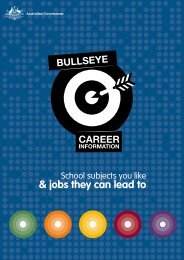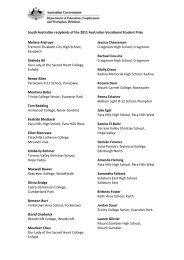Belonging, Being and Becoming - Early Years Learning Framework
Belonging, Being and Becoming - Early Years Learning Framework
Belonging, Being and Becoming - Early Years Learning Framework
Create successful ePaper yourself
Turn your PDF publications into a flip-book with our unique Google optimized e-Paper software.
OUTCOME 5:<br />
CHILDREN ARE EFFECTIVE<br />
COMMUNICATORS<br />
Communication is crucial to belonging, being <strong>and</strong> becoming.<br />
From birth children communicate with others using<br />
gestures, sounds, language <strong>and</strong> assisted communication.<br />
They are social beings who are intrinsically motivated to<br />
exchange ideas, thoughts, questions <strong>and</strong> feelings, <strong>and</strong> to<br />
use a range of tools <strong>and</strong> media, including music, dance <strong>and</strong><br />
drama, to express themselves, connect with others <strong>and</strong><br />
extend their learning.<br />
Children’s use of their home languages underpins their<br />
sense of identity <strong>and</strong> their conceptual development.<br />
Children feel a sense of belonging when their language,<br />
interaction styles <strong>and</strong> ways of communicating are valued.<br />
They have the right to be continuing users of their<br />
home language as well as to develop competency in<br />
St<strong>and</strong>ard Australian English.<br />
Literacy <strong>and</strong> numeracy capabilities are important aspects<br />
of communication <strong>and</strong> are vital for successful learning<br />
across the curriculum.<br />
Literacy is the capacity, confi dence <strong>and</strong> disposition to<br />
use language in all its forms. Literacy incorporates a<br />
range of modes of communication including music,<br />
movement, dance, story telling, visual arts, media <strong>and</strong><br />
drama, as well as talking, listening, viewing, reading <strong>and</strong><br />
writing. Contemporary texts include electronic <strong>and</strong><br />
print based media. In an increasingly technological world,<br />
the ability to critically analyse texts is a key component<br />
of literacy. Children benefi t from opportunities to<br />
explore their world using technologies <strong>and</strong> to develop<br />
confi dence in using digital media.<br />
Numeracy is the capacity, confi dence <strong>and</strong> disposition<br />
to use mathematics in daily life. Children bring new<br />
mathematical underst<strong>and</strong>ings through engaging with<br />
problem solving. It is essential that the mathematical<br />
ideas with which young children interact are relevant<br />
<strong>and</strong> meaningful in the context of their current lives.<br />
Educators require a rich mathematical vocabulary to<br />
accurately describe <strong>and</strong> explain children’s mathematical<br />
ideas <strong>and</strong> to support numeracy development. Spatial<br />
sense, structure <strong>and</strong> pattern, number, measurement, data<br />
argumentation, connections <strong>and</strong> exploring the world<br />
mathematically are the powerful mathematical ideas<br />
children need to become numerate.<br />
Experiences in early childhood settings build on the range<br />
of experiences with language, literacy <strong>and</strong> numeracy that<br />
children have within their families <strong>and</strong> communities.<br />
Positive attitudes <strong>and</strong> competencies in literacy <strong>and</strong><br />
numeracy are essential for children’s successful learning.<br />
The foundations for these competencies are built in<br />
early childhood.





